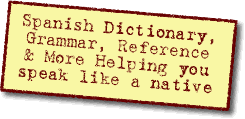Ask a Question(Create a thread) |
|
|||||||
Help with PhrasesTranslate a sentence or longer piece of text. For single words or idioms, use the vocabulary forum. |
 |
|
|
Thread Tools |
|
#1
|
|||
|
|||
|
I am desperate for help on the following frases from English to Spanish:
1. bad wounds heal, bad words are never forgotten 2. good things are done slowly (the one who rushes never achieves good result) 3. you won't find trouble if you stay quiet (be good and you won't get in trouble) 4. the dog will jump according to the stick 5. a well-organised group can lift a mountain (if you work in a team, you can do a lot) Thanks Existe um modismo en Espanol que dice que: Mucho se consigue cuando se trabaja juntos (en equipo)? Last edited by Rusty; February 02, 2014 at 09:50 AM. Reason: merged posts because they are related |
|
Get rid of these ads by registering for a free Tomísimo account.
|
 |
«
Previous Thread
|
Next Thread
»
| Link to this thread | |
|
|
|||||||
 Similar Threads
Similar Threads
|
||||
| Thread | Thread Starter | Forum | Replies | Last Post |
| Helpful phrases | lingos | Vocabulary | 6 | May 27, 2009 01:21 PM |
| A few more phrases | Marsopa | Translations | 10 | April 14, 2009 10:41 AM |
| More phrases | EnglishStudent | Vocabulary | 5 | June 07, 2006 08:43 AM |
| A few phrases | MortgageBroker | Vocabulary | 1 | June 03, 2006 07:50 PM |
| Some phrases | EnglishStudent | Vocabulary | 3 | May 31, 2006 04:03 PM |
All times are GMT -6. The time now is 12:33 PM.







